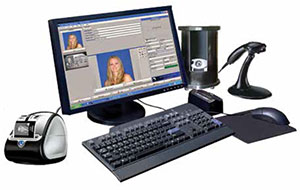
Keeping Control of Who's on Campus
Virtually every school faces the challenge of unknown visitors
- By Anthony Zagami
- Feb 01, 2013
 A typical school has dozens of adults—parents, vendors, volunteers
and others—visiting the campus each day. The overwhelming majority
of these people are honest about their names and intentions
as they sign the registration book. But some lie and others may just
skip the process, walking unchallenged through an open gate. Having
unknown people on campus while children are present can quickly become an
administrator’s nightmare.
A typical school has dozens of adults—parents, vendors, volunteers
and others—visiting the campus each day. The overwhelming majority
of these people are honest about their names and intentions
as they sign the registration book. But some lie and others may just
skip the process, walking unchallenged through an open gate. Having
unknown people on campus while children are present can quickly become an
administrator’s nightmare.
Visitor management is a problem that faces virtually every school, but is particularly
troublesome when more trusting children are present. Creating a safe and
secure place for children starts with proper planning and procedures. Administrators
are no longer in a position to assume that “bad” things happen only at other schools.
Whether it is an urban, suburban or rural school, many share the same security
challenges. For example, enter just about any zip code into the Department
of Justice’s national sex offender registry and don’t be surprised to find multiple
registered sex offenders living a short distance from a school. According to the
National Center for Missing and Exploited Children, there are about 750,000 registered
sex offenders in the United States.
So, what should a school administrator do? Every school needs written, reviewed
and practiced visitor management policies. One of the first steps is making sure there
is only one visitor entrance onto a campus. Once classes begin in the morning, all
but one gate should be locked and remain so as long as children are on site. That one
unlocked gate or door must lead visitors directly into the main office.
Once there, visitors must produce government-issued identification, such as a
driver’s license, to run through an electronic visitor management system that provides
high-speed, level-one checks against local, state and national sexual offender
databases and level-two checks against FBI and state and local law enforcement databases.
A system also should allow districts and individual campuses to set up their
own “deny entry” list and be used to confirm authorization for student pick-ups.
A picture from the ID card or one taken by a networked camera should be
stored in the system for future reference, making it more difficult for a person to
enter the campus using another person’s ID. Once the approval process is complete,
the system should print a wearable photo ID badge, designed to help prevent
passing the badge to an unauthorized person. The printed badge should include
an expiration date and a bar code that can be swiped over a reader as the visitor
leaves to provide a record that he or she has left the campus.
A major goal of visitor management software is to move visitors through the
process as accurately and quickly as possible. First-time visitors should be cleared
and badged in about 15 seconds. It should take only about five seconds to badge
returning visitors.
The system must be easy to use and require little training. Volunteers often are
tasked with maintaining a school’s visitor management efforts. A system also must
be scalable to conform to changes in a campus’ needs.
Here are a few other related benefits that an electronic visitor management system
can provide.
Liability. By checking each visitor entering the school, campus administrators
are showing diligence and continued commitment to keeping unwanted persons
away from students.
Compliance. More than 40 states have some version of the Lundsford Act, first
enacted in Florida in 2005. The law has many requirements intended to keep sex
offenders away from children, including at school. Also known as Jessica’s Law,
the act was passed soon after a Florida girl was sexually battered and murdered by
a previously convicted sex offender.
Safety. If a critical event—such as a bomb threat, active shooter or severe
weather condition—were to impact a campus, administrators need a full inventory
of who is on school grounds; visitor management systems can likewise assist first
responders in accounting for everyone on campus.
Forensic management. System-generated reports can help investigators see who
was on campus when thefts, vandalism and other criminal activities occurred.
Volunteer recognition. Many schools provide awards for top volunteers. A visitor
management system can keep records of the type of visitor and how much time
he or she has spent on campus throughout the school year.
A visitor management system can function as a stand-alone solution for a single
campus or be networked with others in that district to provide more benefits. More
than 300 facilities—schools, education centers and charter schools—are linked via
the district’s virtual public network (VPN).
Networking the systems provides two additional major benefits. Administrators
can use available real-time reports to spot and investigate suspicious patterns,
such as a person moving from campus to campus seeking entry. The system also
can work as a district-wide messaging center. For example, an Amber Alert, severe-
weather warning or other emergency can be communicated instantly to every
workstation on the network.
There are two more important steps, both of which should be part of a school’s
written plan, that can increase the effectiveness of an electronic visitor management
system.
- Teachers and staff must wear photo ID badges while on campus. With all approved
adults—including visitors—clearly badged, students will be able to spot
someone they can trust during an emergency.
- Teachers and staff need to immediately challenge any adult on campus not
wearing a permanent or temporary ID badge. If the challenged person fails to
immediately head to the office for a temporary badge, he or she should be asked
to immediately leave the campus. Failure to do so should result in a call to local
law enforcement.
There also are some additional low-tech security measures that should be part
of the plan. Fencing can close off areas and help lead visitors to the correct entry.
Also, signage can help direct people to the office and provide valuable information,
such as the hours a school is open and the proper credentials required to gain
campus access.
Too many schools still allow people to enter unchallenged. But with so many
potential dangers to people and property, administrators can no longer tolerate an
open campus. An electronic visitor management system, along with well-written
policies and procedures, provides a quick and simple solution to enable appropriate
people to enter while preventing visitors with no legitimate
business on campus from entering the building. While students
are the biggest security concern in a school, the system also helps
protect faculty, staff, volunteers and vendors.
This article originally appeared in the February 2013 issue of Security Today.